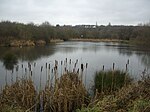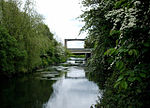Woodhouse railway station

Woodhouse railway station serves Woodhouse and Woodhouse Mill in Sheffield, South Yorkshire, England. The station is 5.25 miles (8 km) east of Sheffield station on the Sheffield to Lincoln Line. The next station east was Waleswood, until its closure in 1955, and is now Kiveton Bridge. The next station west is Darnall. Beighton railway station, originally adjacent to the junction with the Midland Railway, but rebuilt by the MS&LR when it began work on its "Derbyshire Lines", was until 1954 the next station south. Woodhouse Mill, Orgreave and Fence were served by a station on the North Midland Railway named Woodhouse Mill. From 1955 until removal in 1981, the Barnsley Junction-Rotherwood segment of the Manchester – Sheffield – Wath electrification terminated slightly west of the Woodhouse station platforms, within sight of the station.
Excerpt from the Wikipedia article Woodhouse railway station (License: CC BY-SA 3.0, Authors, Images).Woodhouse railway station
Driver Street, Sheffield Woodhouse
Geographical coordinates (GPS) Address Nearby Places Show on map
Geographical coordinates (GPS)
| Latitude | Longitude |
|---|---|
| N 53.36382 ° | E -1.35753 ° |
Address
Driver Street
S13 9WP Sheffield, Woodhouse
England, United Kingdom
Open on Google Maps







